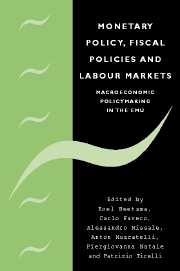Book contents
- Frontmatter
- Contents
- List of figures
- List of tables
- List of contributors
- Acknowledgements
- Editors' introduction
- Part I Monetary policy
- 1 The European Central Bank: a view from across the ocean
- 2 Which measure of inflation should the ECB target?
- 3 An evaluation of alternative targeting rules for the ECB
- 4 Inflation modelling in the euro area
- Part II Fiscal policies
- Part III Labour markets
- Index
1 - The European Central Bank: a view from across the ocean
from Part I - Monetary policy
Published online by Cambridge University Press: 22 September 2009
- Frontmatter
- Contents
- List of figures
- List of tables
- List of contributors
- Acknowledgements
- Editors' introduction
- Part I Monetary policy
- 1 The European Central Bank: a view from across the ocean
- 2 Which measure of inflation should the ECB target?
- 3 An evaluation of alternative targeting rules for the ECB
- 4 Inflation modelling in the euro area
- Part II Fiscal policies
- Part III Labour markets
- Index
Summary
As I write, the European Central Bank approaches its third anniversary of operational responsibility for the monetary policy of the Eurosystem. The thousands of people involved in coaxing this new institution into existence have done an extraordinary job. Against formidable odds and the dire predictions of numerous observers, their insights and hard work have manufactured an extraordinary product. I am in awe of the job that has been done in Frankfurt by the Executive Board and the staff of the ECB itself, and by the governors and staffs of what today are twelve national central banks (the NCBs) who have joined the European Monetary Union. The real measure of the success of the European System of Central Banks (ESCB) is how truly minor all of our criticisms are. I seriously doubt that any of us could have done better.
In this chapter I will comment on a number of aspects of the ESCB. Throughout I will try to provide comparisons with the structure of other central banks, especially the Federal Reserve System. I begin with a discussion of institutional structure, followed by a critical examination of the Eurosystem's ‘two-pillar’ policy strategy. I then discuss issues of communication and transparency, followed by a very brief examination of policy performance and a conclusion that describes some future challenges.
Institutional structure
Economists often ignore one of the central precepts of other social science disciplines: institutional structure is crucial for policy outcomes.
- Type
- Chapter
- Information
- Monetary Policy, Fiscal Policies and Labour MarketsMacroeconomic Policymaking in the EMU, pp. 9 - 19Publisher: Cambridge University PressPrint publication year: 2004
- 1
- Cited by



